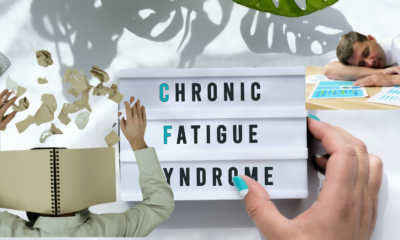Health & Fitness
Eating Disorders: Recognizing the Signs and Getting Help

Eating disorders, often misunderstood as mere lifestyle choices, are complex mental health conditions that affect millions of people globally. Their impact extends beyond the visible signs of weight loss or gain, weaving deeply into the emotional, psychological, and social fabric of an individual’s life. Understanding eating disorders requires a comprehensive look at their causes, symptoms, societal impact, and the various avenues available for treatment and recovery. This article explores the multifaceted nature of eating disorders, focusing on recognizing the signs and providing practical guidance on seeking help.
Introduction to Eating Disorders
Eating disorders are severe disturbances in eating behavior, characterized by extreme concern over body weight and shape. They typically manifest through unhealthy and dangerous eating patterns, including restricting food intake, binge eating, or purging behaviors. These disorders are not just about food; they often stem from deeper emotional and psychological issues.
Eating disorders predominantly affect adolescents and young adults, though they can arise at any age. Women are statistically more likely to suffer from these disorders, but men are also vulnerable, and the number of male cases is rising. Furthermore, eating disorders affect people across all races, ethnicities, and socioeconomic backgrounds, challenging the outdated notion that these disorders are confined to a particular demographic.
The three most common types of eating disorders are:
1) Anorexia Nervosa
2) Bulimia Nervosa
3) Binge Eating Disorder (BED)
Each of these conditions presents differently but shares a common theme: a disordered relationship with food and body image.
Causes and Risk Factors
Eating disorders arise from a complex interplay of genetic, psychological, social, and environmental factors. These disorders rarely have a single cause, but instead develop from multiple contributing factors, which may include:
1) Genetic Factors
Research has shown that eating disorders can run in families. Genetic predispositions can increase an individual’s susceptibility to these disorders. If a close relative has experienced an eating disorder, other family members may be at greater risk. Studies have suggested that specific genes influence traits such as perfectionism, anxiety, and emotional sensitivity, which are often seen in individuals with eating disorders.
2) Psychological Factors
Many people with eating disorders suffer from underlying psychological conditions such as depression, anxiety, or obsessive-compulsive disorder (OCD). Low self-esteem, feelings of inadequacy, and a tendency toward perfectionism are also common traits. These psychological struggles often push individuals toward unhealthy behaviors in an attempt to gain a sense of control over their lives, especially regarding food and body image.
3) Cultural and Societal Influences
In many societies, thinness is equated with beauty, success, and self-worth. Social media, advertising, and celebrity culture often glorify unrealistic body standards, contributing to body dissatisfaction and the development of eating disorders. Constant exposure to these ideals can result in individuals developing unhealthy coping mechanisms, using food as a means to gain control or conform to perceived societal expectations.
4) Trauma and Life Events
Traumatic experiences, such as abuse, the death of a loved one, or significant life transitions, can trigger the onset of an eating disorder. Individuals who have experienced emotional, physical, or sexual abuse are particularly vulnerable. For some, an eating disorder may develop as a way to numb emotional pain or regain a sense of control when other areas of life feel chaotic.
5) Environmental Factors
Environmental stressors, such as peer pressure, family dynamics, and competitive academic or athletic environments, can increase the likelihood of developing an eating disorder. For example, certain sports, such as gymnastics, ballet, and wrestling, place high importance on maintaining a specific body weight or shape, which can drive athletes toward disordered eating behaviors.
Types of Eating Disorders and Their Symptoms
Understanding the different types of eating disorders is crucial for recognizing the signs in yourself or others. Each disorder manifests differently, but there are overlapping symptoms that highlight a troubled relationship with food and body image.
Anorexia Nervosa
Anorexia nervosa is characterized by extreme food restriction, an intense fear of gaining weight, and a distorted body image. Individuals with anorexia often perceive themselves as overweight, even when they are dangerously underweight. This disorder has the highest mortality rate of any psychiatric condition, primarily due to the severe physical consequences and the risk of suicide.
Symptoms of Anorexia Nervosa:
- Drastic weight loss or failure to meet expected growth patterns in children and adolescents.
- Obsession with food, dieting, and calorie intake.
- Excessive exercise or physical activity.
- Intense fear of gaining weight or becoming “fat,” even when underweight.
- Refusal to maintain a healthy weight, often accompanied by denial of the severity of weight loss.
- Social withdrawal and avoidance of eating in public.
- Preoccupation with body size, shape, or specific parts of the body.
- Physical symptoms include fatigue, dizziness, thinning hair, brittle nails, and irregular menstruation in females.
Bulimia Nervosa
Bulimia nervosa involves recurrent episodes of binge eating followed by compensatory behaviors, such as self-induced vomiting, excessive exercise, or the misuse of laxatives, to prevent weight gain. Unlike individuals with anorexia, those with bulimia may maintain a relatively normal body weight, which can make the disorder harder to detect.
Symptoms of Bulimia Nervosa:
- Frequent episodes of eating unusually large amounts of food in a short period, often accompanied by a feeling of being out of control.
- Engaging in compensatory behaviors like vomiting, fasting, excessive exercise, or using laxatives to prevent weight gain.
Preoccupation with body shape and weight, often accompanied by feelings of guilt, shame, or embarrassment about eating behaviors.
- Damage to the digestive system, chronic sore throat, swollen glands, tooth decay, and acid reflux due to repeated vomiting.
- Scarring on the hands or knuckles from inducing vomiting (known as “Russell’s sign”).
- Secrecy around eating habits and avoidance of eating with others.
Binge Eating Disorder (BED)
Binge Eating Disorder is the most common eating disorder in the United States. It is characterized by recurring episodes of eating large quantities of food, often quickly and to the point of discomfort. Unlike bulimia, individuals with BED do not regularly use compensatory behaviors, which often leads to weight gain and obesity.
Symptoms of Binge Eating Disorder:
- Eating large amounts of food in a short period, even when not physically hungry.
- Eating until uncomfortably full or feeling distressed, ashamed, or guilty after overeating.
- Eating alone or in secret due to embarrassment about the quantity of food consumed.
- Frequent dieting without any lasting weight loss.
- Weight fluctuations, often leading to obesity and associated health risks such as diabetes, heart disease, and hypertension.
Recognizing the Signs of Eating Disorders
Identifying the signs of an eating disorder is often challenging, especially since individuals suffering from these conditions may go to great lengths to hide their behaviors. However, there are several warning signs that friends, family, and healthcare professionals can look out for.
Physical Signs:
- Noticeable weight fluctuations (both loss and gain).
- Fatigue, weakness, and overall decline in physical health.
- Gastrointestinal issues such as constipation, acid reflux, and stomach pain.
- Dizziness, fainting, or frequent headaches.
- Disrupted or missed menstrual cycles in females.
- Dry skin, brittle nails, and thinning hair.
Behavioral Signs:
- Preoccupation with food, dieting, and body weight or shape.
- Refusal to eat certain foods or food groups, often labeling them as “bad” or “unhealthy.”
- Ritualistic eating patterns, such as cutting food into tiny pieces, eating very slowly, or rearranging food on the plate.
- Avoidance of social situations involving food.
- Secretive behaviors around eating, such as hiding food or binge eating in private.
- Wearing loose clothing to hide body shape or weight loss.
Emotional Signs:
- Intense fear of gaining weight or becoming overweight, even when underweight.
- Low self-esteem, often tied to body image and perceived flaws.
- Mood swings, irritability, and difficulty concentrating.
- Feelings of guilt or shame after eating, particularly after binge episodes.
- Anxiety or depression, sometimes resulting in social withdrawal or isolation.
The Consequences of Eating Disorders
Eating disorders are not just mental health conditions; they also take a severe toll on the body. The longer an eating disorder goes untreated, the more dangerous the consequences become. Chronic eating disorders can lead to a range of physical health issues, some of which can be life-threatening.
1) Cardiovascular Complications
Severe food restriction, binge eating, and purging behaviors can lead to dangerous imbalances in the body’s electrolytes, which are critical for heart function. Low potassium levels, for example, can result in irregular heart rhythms, known as arrhythmias, which can be fatal. Additionally, chronic malnutrition weakens the heart muscle, increasing the risk of heart failure.
2) Bone Health
People with anorexia nervosa are at high risk for developing osteoporosis due to prolonged malnutrition, particularly when the disorder begins in adolescence when bone growth is most important. Low body weight, hormonal imbalances, and nutrient deficiencies contribute to the weakening of bones, which can lead to fractures and long-term complications.
3) Digestive Problems
Individuals with bulimia often experience chronic gastrointestinal problems. Repeated vomiting can lead to severe acid reflux, esophageal damage, and chronic sore throats. Additionally, the misuse of laxatives can cause long-term damage to the digestive system, leading to constipation and bloating.
4) Endocrine Disruptors
Eating disorders, particularly anorexia, disrupt the body’s hormonal balance. In females, this often leads to amenorrhea (the absence of menstruation), which is a sign that the body is not receiving enough energy to sustain basic functions. Over time, endocrine dysfunction can impact fertility and sexual health.
5) Mental Health
Eating disorders are closely linked to other mental health conditions, including depression, anxiety, and substance abuse disorders. The emotional toll of living with an eating disorder, combined with the stigma and secrecy often associated with these conditions, can lead to feelings of isolation and hopelessness. Individuals with eating disorders are also at higher risk for self-harm and suicide.
Getting Help: Pathways to Recovery
Recovery from an eating disorder is possible, but it requires a multifaceted approach that addresses the physical, emotional, and psychological aspects of the condition. Early intervention is crucial for improving outcomes, but it’s never too late to seek help. The following steps can guide individuals and their loved ones toward recovery.
Recognizing the Need for Help
The first step toward recovery is acknowledging that there is a problem. This can be one of the most challenging steps for individuals suffering from an eating disorder, as denial and secrecy are common. However, recognizing the physical, emotional, and behavioral signs is critical. If you or someone you know is exhibiting these symptoms, it’s important to seek professional help.
Seeking Professional Support
Eating disorders require specialized treatment from healthcare providers who understand the complexity of these conditions. A multidisciplinary team often includes:
- Medical Doctors: To monitor physical health, particularly in cases of malnutrition, electrolyte imbalances, and other complications.
- Psychologists or Psychiatrists: To address the underlying emotional and psychological issues contributing to the eating disorder.
- Nutritionists or Dietitians: To help individuals develop a healthy relationship with food and learn balanced eating habits.
- Therapists (e.g., Cognitive Behavioral Therapy – CBT): To help challenge distorted thinking patterns, build self-esteem, and develop coping mechanisms.
Types of Treatment
Treatment plans are individualized based on the severity of the eating disorder and the patient’s specific needs. Common treatment approaches include:
- Inpatient or Residential Treatment: For individuals with severe eating disorders, hospitalization or residential treatment may be necessary to stabilize physical health and provide round-the-clock support.
- Outpatient Treatment: For those whose eating disorders are less severe or who have made progress in treatment, outpatient therapy can provide ongoing support through regular appointments with a healthcare team.
- Nutritional Counseling: Nutritionists or dietitians play a key role in helping individuals restore healthy eating patterns and dispel myths about food and body weight.
- Psychotherapy: Cognitive Behavioral Therapy (CBT) is the most widely used form of therapy for treating eating disorders. Other therapies, such as Family-Based Treatment (FBT) and Dialectical Behavior Therapy (DBT), can also be effective.
Support Systems
Having a strong support system is vital in the recovery process. Family and friends play a crucial role in providing emotional support and encouragement. Many individuals with eating disorders also benefit from joining support groups, where they can connect with others who understand their struggles.
Building a Healthy Relationship with Food
Recovering from an eating disorder involves more than just gaining weight or stopping purging behaviors. It’s about building a healthy, balanced relationship with food and learning to listen to the body’s natural hunger and fullness cues. This process takes time and requires patience, but with the right support, individuals can regain control over their lives and achieve lasting recovery.
Conclusion
Eating disorders are complex, multifaceted mental health conditions that can have devastating effects on both physical and emotional well-being. Recognizing the signs of an eating disorder early on can make a significant difference in treatment outcomes. While the road to recovery may be long and challenging, it is possible with the right combination of professional support, therapy, and a strong support network.
If you or someone you know is struggling with an eating disorder, it’s important to seek help as soon as possible. Recovery is not just about changing eating habits; it’s about addressing the underlying emotional and psychological issues that contribute to disordered eating. With the right help and support, individuals can overcome these disorders and lead healthy, fulfilling lives.
-

 Gadgets & Electronics7 days ago
Gadgets & Electronics7 days agoComprehensive Acer Chromebook Laptop Reviews: Unveiling the Best Models of 2025
-

 Cryptocurrency7 days ago
Cryptocurrency7 days agoBlockchain Beyond Cryptocurrency: 5 Game-Changing Applications You Should Know
-

 Education7 days ago
Education7 days agoUnlocking Knowledge: How the Udemy App Transforms Online Learning
-

 Government7 days ago
Government7 days agoTrump Administration Targets Harvard: Federal Contracts and International Students at Risk
-

 Art & Culture7 days ago
Art & Culture7 days agoThe Ultimate Guide to Nails Hollywood: Trends, Styles, and Top Salons in 2025
-

 Art & Culture7 days ago
Art & Culture7 days agoDiscover the Best Romance Movies on Netflix: Your Ultimate Guide for 2025
-

 Business7 days ago
Business7 days agoIs the Housing Market Going to Crash in 2025? Insights and Predictions Ahead
-

 Business7 days ago
Business7 days agoIs the Housing Market Going to Crash in 2025? Insights and Predictions Ahead





































